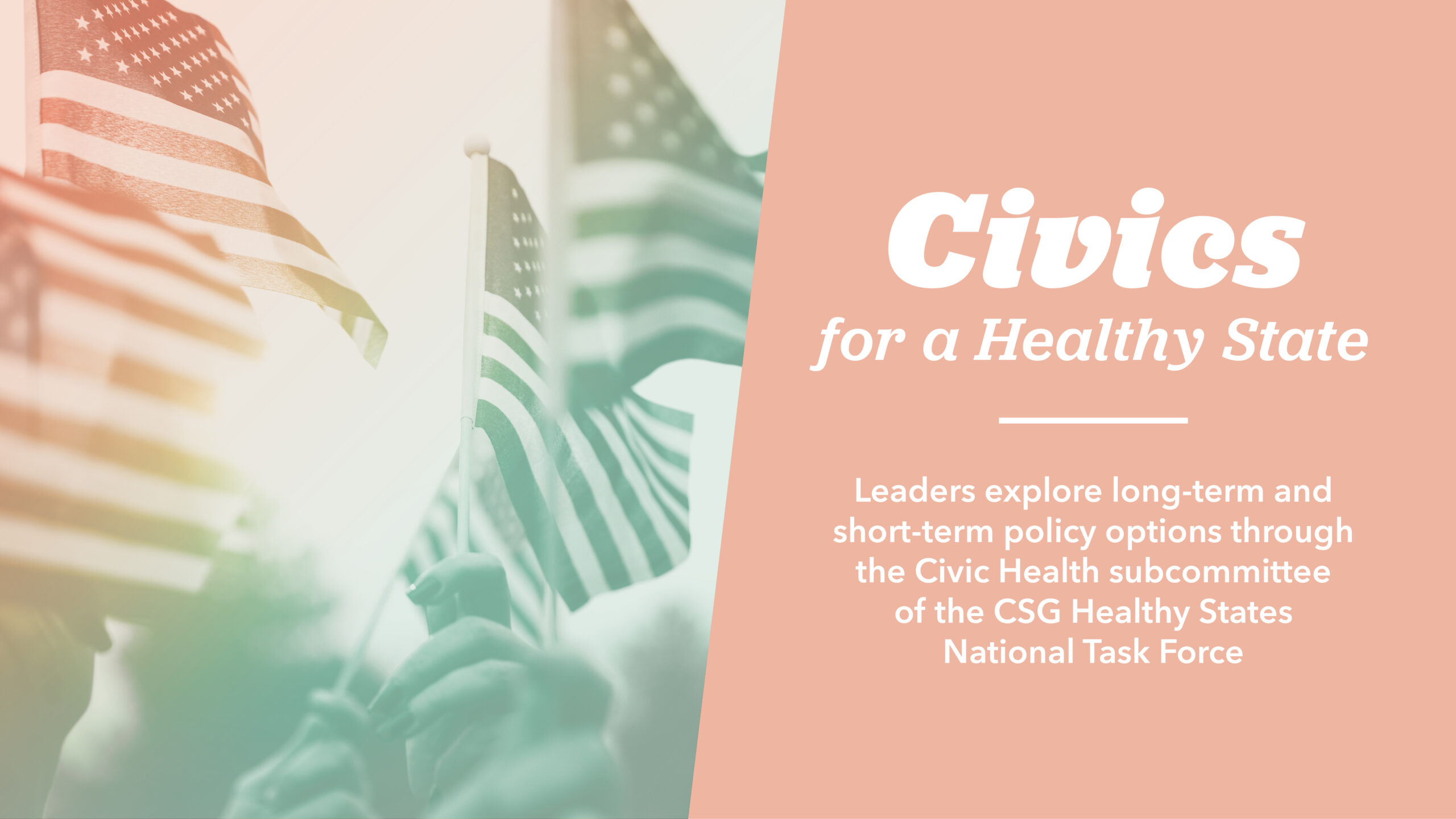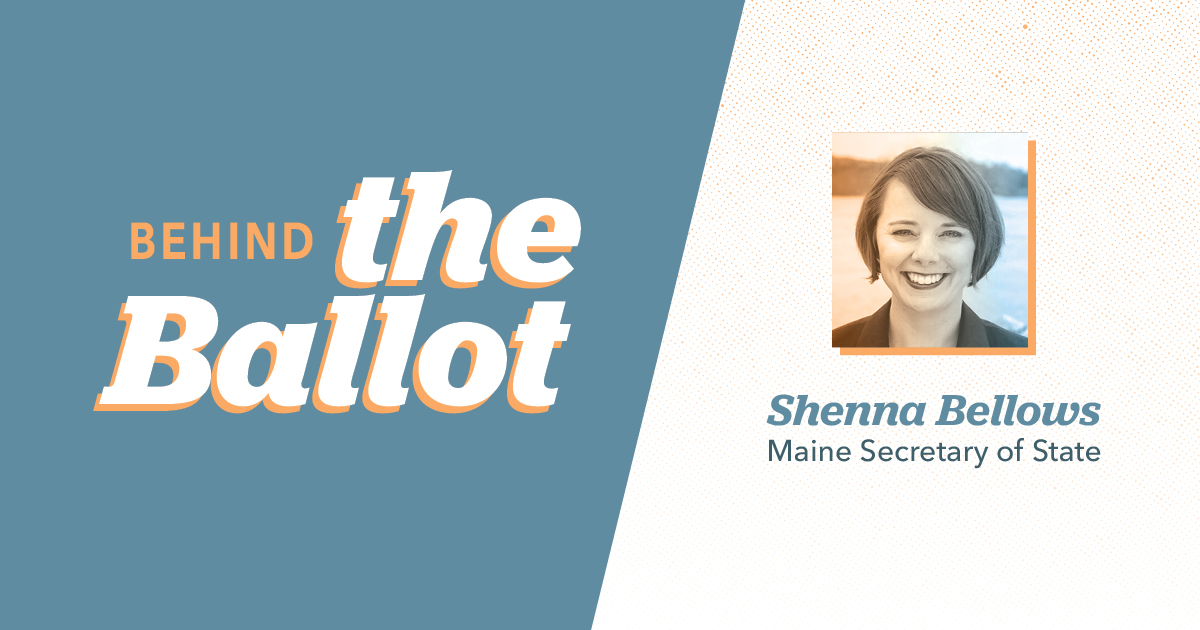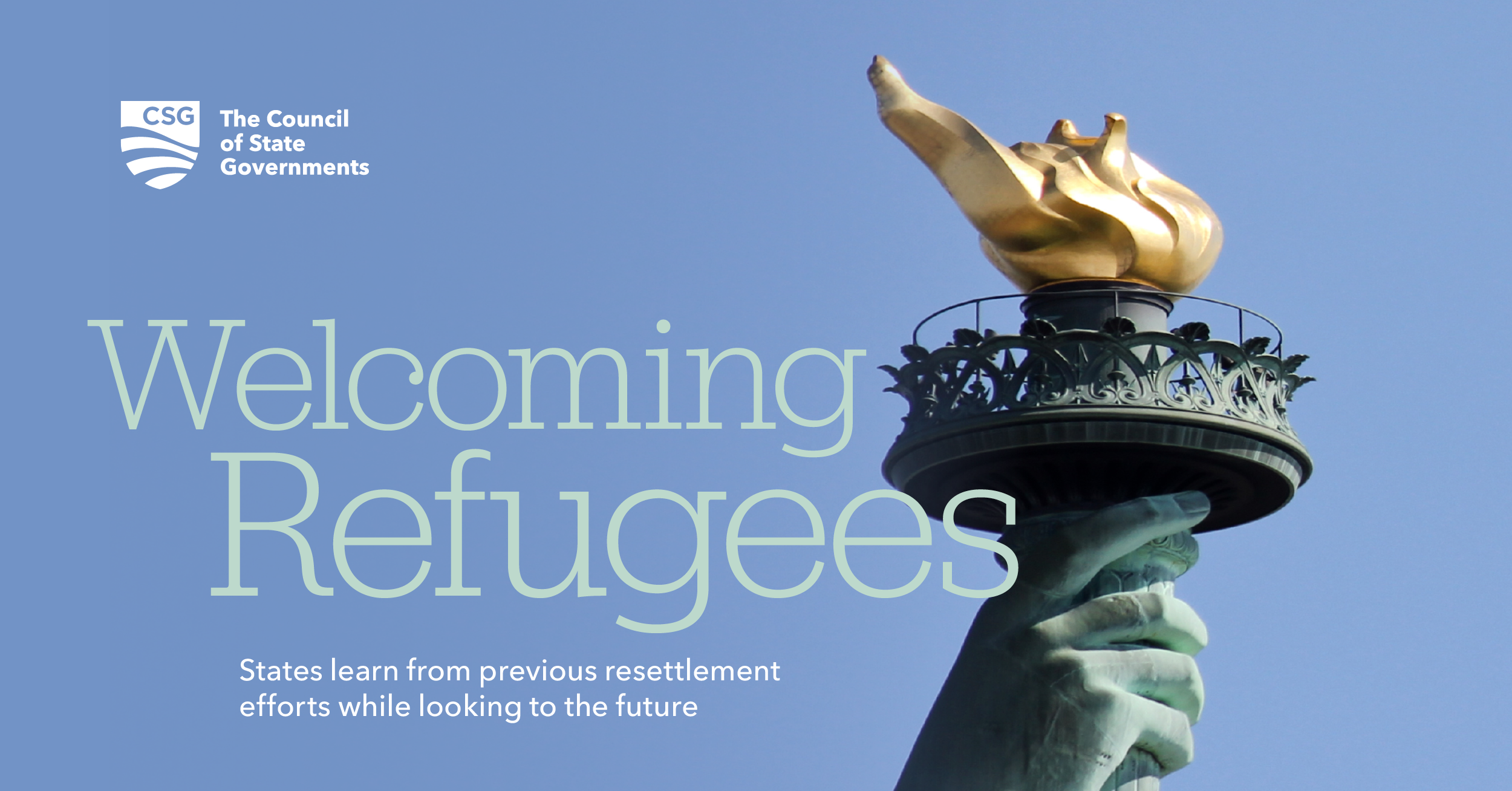States use innovative strategies to ensure voting access for voters with disabilities and military and overseas voters.
Continue readingCivics for a Healthy State
By Carl Sims
The CSG Civic Health Subcommittee of the Healthy States National Task Force is exploring how states can improve civic discourse and participation through immediate-term actions by state leaders and long-term investments in civic education.
The subcommittee is part of a larger initiative — the 2021-22 CSG Healthy States National Task Force. A bipartisan working group of state leaders from all three branches of government, the task force is working to provide resources and recommendations for state governments on how to best address current state challenges, including those resulting from and intensified by the COVID-19 pandemic.
Supported by CSG staff and other subject matter experts, the task force focuses on four key policy areas to provide states a holistic policy strategy for their shared challenges. In addition to civic health, the national task force is exploring infrastructures related to fiscal health, workforce and economic health and human health. Click here to learn more about the 2021-22 CSG Healthy States National Task Force.
Tennessee state Sen. Bo Watson and Delaware state Sen. Bryan Townsend, who co-chair the national task force, say civic health represents a basic building block of a free society. Without a minimum understanding of how government works, or their role in it, citizens will not be able to fulfill their obligations to each other — or to the future.
“A fundamental tenet of our democratic republic is that an educated citizenry is a vital requisite for our survival as a free people; therefore, to be civically healthy it is imperative that our citizens understand how our system of government operates so they can best engage and hold accountable the government they elect,” Watson said.
For Townsend, civic health is built on the faith citizens have in one another and in their institutions of government. Consequently, he says it’s vitally important that people — elected leaders and citizens alike —learn ways to disagree without becoming “toxically disagreeable.”
“Civic health is the measure of how well we have adopted such an approach, building the necessary systems and culture of using them,” he said. “Without it, our disagreements will consume us and the potential of America.”
Considerations for Leaders
The Civic Health subcommittee addresses foundational questions around building healthy and resilient democratic institutions and advancing civic education. Maine Secretary of State Shenna Bellows, who co-chairs the subcommittee with Ohio Secretary of State Frank LaRose, says she is most excited by the subcommittee’s meaningful and civil engagement across party lines.
“The committee itself is comprised of elected officials with diverse roles representing both major political parties, and the diversity of political background and experience has deepened the conversations about what the health of our civic institutions can look like if we truly engage with one another,” she said. “It’s been fascinating to find that sometimes we agree on principles but not on word choices. Breaking through that initial resistance to try to find shared understanding is really important. We’re in a dangerous moment for our democracy, and finding a path forward is going to require dialogue, especially when it’s difficult.”
Subcommittee members have suggested that leaders can improve public trust in government institutions and improve civic discourse by utilizing the capacity and profile of their office. In particular, state leaders may consider the following:
• Proactively combatting misinformation and disinformation as it is occurring. Additionally, and to help in that effort, state leaders should have strong social media presences and post regularly, even outside of major events like elections, to build legitimacy and maintain a steady stream of reliable civic information.
• Working on one’s emotional intelligence to make bipartisan solutions more possible.
• Recognizing how humans respond organically to context, structure and signals and require a feeling of safety for difficult conversations.
• Creating discourse among differing groups by establishing values and a vision. Ask participants: “What do we want to be true of the place where we live?”
Subcommittee members say these actions can be complemented by long-term investments in K-12 civic education. Evidence suggests a connection between civic education and civic engagement. According to a 2011 report titled, “Guardian of Democracy: The Civic Mission of Schools,” students who receive high-quality education are more likely to “understand public issues, view political engagement as a means of addressing communal challenges, and participate in civic activities.”
Current challenges to a robust civic education framework include the following:
• A 2020 poll from the Annenberg Constitution Day Civics Survey found that only 51% of Americans polled could name all three branches of government.
• The federal government invests five cents per student for civics, but $54 per student for STEM.
• Student performance on the National Assessment of Educational Progress in Civics is stagnant, with civic knowledge and skills spread inequitably by race/ethnicity.
States can also consider how civic education must celebrate the country’s accomplishments while acknowledging the country’s difficult history and its difficult present. Improvements to a civic education framework may include greater funding for civic education, strengthening course requirements and assessments, reforming education standards and curriculum and enhancing accountability.
Civic health presents a number of areas where state leaders can come together to collaborate to build civic engagement. For Bellows, one of the most promising areas is election access and voting rights.
“I think it’s important that we continue to find ways to get back to a place where strengthening and protecting voting rights for all American citizens is a shared goal for all state leaders,” she said. “Civic health ultimately depends upon a healthy democracy where every citizen has equal access to exercise their constitutional rights to register to vote, cast their ballot and have their vote to be counted. Regardless of who we are or where we come from, everything else we care about depends upon that.”
Townsend and Watson both identify the unique opportunity — and responsibility — states have in advancing civic health.
“A principle of a democratic republican form of government is that the government that governs closest to the people, governs best; therefore, the states, in our federal system of government, have the primary duty and responsibility of providing civic education to their citizens since it is the states that have the most intimate relationship with their citizens,” Watson said. “In order for states to fully exercise the power afforded to them in the U.S. Constitution and to hold the federal government accountable, it is essential that states educate their citizens on how our government is structured, how it operates, how to engage it and how to hold it accountable.”
Townsend noted that, even though national government has become dominant in the federalist system, state governments must take the lead in advancing civic health.
“As our federalist system experiences tension from this preemption, the states still remain uniquely positioned to provide a renaissance in civic health by movingly nimbly to respond to individual state-level issues and evidencing to the electorate the ability of government to respond to the people. Such is the system design; we desperately need the states to fulfill this role.”
Learn more about the Civic Health subcommittee and explore resources at: web.csg.org/csghealthystates/civic-health.
Behind the Ballot with Sec. Bellows
Shenna Bellows – Maine’s Secretary of State
Shenna Bellows has served as the executive director to the Holocaust and Human Rights Center as well as the American Civil Liberties Union of Maine. She was a Maine senator for four years before being selected by the Maine Legislature to serve as secretary of state. Throughout her career, and specifically in her role as secretary, Bellows has led with the philosophy of “radical transparency,” and this election season is no different.
Bellows says that she and her staff are fighting against the brewing distrust of the voting process and widespread misinformation with open communication to the people of Maine.
“Everything that we do, we share,” she said. “We have published voter information guides, we work with our local election officials to help conduct radio interviews to talk through election processes, not just once in election season, but in an ongoing basis. We have relationships with our radio hosts, with our television broadcasters and the local media so that they understand how our elections are administered.”
Partisan pushbacks are an area of concern across the nation. However, Maine’s deliberate bipartisan efforts have been extremely helpful in building back voter confidence. The state has codified law that requires an equal representation of Democrats and Republicans at the polls, information Bellows has used to ease the minds of voters and even recruit volunteers. This upcoming election season, state leaders are grappling with a drop in local election clerks, in-part due to the rise in animosity toward elections. Maine’s elections are run through municipalities, as opposed to being county-based and rely on over 500 election officials to administer state, local and federal elections.
“One of the trends that we’re seeing that’s happening across the country is the retirement and turnover among local election officials. That’s precipitated in part because of a rise in threats against election workers and people being more extreme or angry when they’re interacting with their local election officials, which has made the job more challenging,” Bellows said.
However, new bi-partisan legislation has put in place protections for poll workers in addition to bolstering the security and efficiency of elections.
“We’ve been successful in our state legislature. The legislation to protect election workers was bipartisan and we were also able to work collaboratively in the legislature to secure additional resources for training and post-election audits to help strengthen public trust and the accuracy and security of our elections. So, we’ve been really pleased to see that.”
Maine was one of the first states to introduce and adopt ranked choice voting with overwhelming support from voters. For Bellows, it was important to make this new voting process visible for all Mainers, which she says helped boost voter trust.
“Like any other aspect of elections, what’s most important is to be fully transparent about how it works,” she said. “Live streaming the ranked choice voting tabulation, for example, helps people understand how that works. Making sure that we test some of our materials like ballot design and voting for people with disabilities with representatives from the disabilities community before we launch has increased voter confidence as well.”
Beyond the ballot, Secretary Bellows is optimistic for a future of positive change. To achieve that future, she’s relying on her ideals of valiant honesty and fairness through cross-party collaboration.
“We can only achieve permanent and lasting positive change if we work together and bipartisan coalitions to get things done. Our country depends on a process. That entails checks and balances and the free and fair debate of ideas.
“The principle of no permanent friends and no permit enemies is one that I brought with me into elected office, because I think it’s really important to look past where we come from or our political affiliation to try to reach common ground around shared values.”
Justice for All
Michigan Chief Justice Bridget McCormack says civic health starts with justice reform.
Continue readingWelcoming Refugees
States learn from previous resettlement efforts while looking to the future.
Continue readingState Approaches to School Safety
By Jennifer Horton
This article is based on research conducted by CSG analysts in response to several inquiries from state leaders. Have a question of your own? Email [email protected].
Many states are assessing their approaches to school safety and exploring opportunities to take action through policy. While the federal government has published guidelines and resources outlining best practices to support schools in creating safe learning environments, much of the work of improving school safety falls to state and local governments and school districts. A scan of state policy initiatives conducted by The Council of State Governments reveals that states have taken a range of approaches to the issue.
Some states — like New York, which passed a comprehensive 10-bill legislative package in June to strengthen gun laws — are addressing the issue by focusing on general gun safety measures. In a violence prevention plan, a coalition of school safety researchers and experts recommend several research-informed actions state leaders can take to prevent fatal mass shootings and other forms of gun violence. The plan’s points include:
- Comprehensive background checks
- Licenses to purchase handguns
- Bans on assault-style weapons and high-capacity ammunition clips
- Extreme risk protection laws
- Improved gun storage at home
An analysis of targeted school violence conducted by the Secret Service found that 76% of the attackers who used firearms acquired the weapon from the home of a parent or other close relative. In half of the firearms cases, attackers used guns that were either easily accessible or not securely stored. In 16% of cases, the firearms were kept more securely, but the attacker was still able to gain access to them.
Other states have focused on school-specific strategies, enacting laws that require school districts to develop and implement school safety plans centered on prevention and response. California, Texas and Washington all require safety plans, with mixed levels of enforcement and accountability. Prevention often takes the form of “school hardening”, which attempts to fortify schools against gun violence through security measures such as implementing metal detectors, controlled access protocols, reinforced steel doors and better locks and hiring school resource officers.
In addition to hardening measures, some states are looking at ways to “soften” schools by supporting the social and emotional needs of students, building empathy and strengthening their conflict resolution and stress management skills. The Secret Service report found that most attackers experienced social stressors involving relationships, were victims of bullying and endured negative home life factors. Many states are using American Rescue Plan Act funding to address student mental health. For example, the Choose Love for Schools initiative promotes a research-informed social and emotional learning curriculum designed to create a safer and more connected school culture. It has been downloaded by more than 10,000 schools in all 50 states.
States have also worked to strengthen responses to an active shooter situation in efforts to minimize harm. Iowa and Washington require school districts to coordinate with local law enforcement to develop school safety plans. Allen, Edmonton, Grayson, Mercer, Warren and Scott counties in Kentucky installed fast paths to assist law enforcement in navigating school buildings quickly. New Jersey’s Department of Education implemented a similar system.
Specific examples of state legislation addressing school safety can be found in the tables below.
Summary of Legislation and Code Concerning School Hardening
| State | Bill | Status | Summary |
| Florida | Statute 1001.212 | 2020 Enacted | Establishes a school security risk assessment tool, a School Safety Specialist Training Program and a School Hardening and Harm Mitigation Workgroup; awards grants to improve the safety and security of school buildings. |
| Kentucky | House Bill 63 | 4/08/22 Enacted | Requires a school resource officer be assigned to each school. |
| Michigan | Senate Bill 990 | 3/21/2019 Enacted | Prohibits schools from building a new school facility or conducting major renovations without consulting with the law enforcement agency that is the first responder for that building. |
| Michigan | House Bill 5701 | 3/23/2022 Enacted | Allows schools to install temporary door locking systems with fewer regulations and restrictions. |
| Texas | Senate Bill 11 | 6/06/2019 Enacted | Requires open-enrollment charter schools to be subject to Sec. 37.108 which requires school districts to adopt and implement a multi-hazard emergency operations plan; adds preventionas part of multi-hazard plans; requires district employees to have access to telephones to ensure communication during an emergency; allows districts to “harden” schools from external threats. |
Summary of Legislation and Code Concerning Active Shooter Response in Schools
| State | Bill | Status | Summary |
| California | Assembly Bill 1747 | 9/27/2018 Enacted | Instructs all K-12 public schools to develop a comprehensive school safety plan and train all school staff in the plan; plans must include procedures related to individuals with guns on school campuses and at school-related functions; school districts are to coordinate emergency response drills with local first responder agencies. |
| Florida | Senate Bill 7026 | 3/9/2018 Enacted | Requires each district school board to formulate and prescribe policies and procedures in consultation with the appropriate public safety agencies for emergency drills for hostage and active shooter situations. |
| Illinois | House Bill 2400 | 8/16/2021 Enacted | Provides that a law enforcement lockdown drill must: not include simulations that mimic an actual school shooting incident or active shooter event,be announced in advance to all school personnel and students,include content that is age and developmentally appropriate, include and involve school personnel, including school-based mental health professionals, and include trauma-informed approaches to address the concerns and well-being of students and school personnel. Requires a school district to include an examination of the efficacy and effects of law enforcement drills in its annual review of each school building’s emergency and crisis response plans, protocols and procedures. |
| Iowa | Senate File 2364 | 4/11/2018 Enacted | Requires the board of directors of all school districts and the authorities in charge of each accredited non-public school to develop high quality emergency operations plans for school buildings, to include potential threats from active shooters; requires at least one emergency operations drill be conducted each year in the school building, with the specifics of who participates and what the drill includes left to the authorities. |
| Kentucky | KRS 156.095 (7) | 2/21/2020 Enacted | Requires a minimum of one hour of training on how to respond to an active shooter situation for all school district employees with job duties requiring direct contact with students; requires active shooter training only for staff (students do not participate — students prepare for active shooter emergencies through lockdown drills). |
| Montana | Code Annotated 20-1-401 and 20-1-402 | 2021 Enacted | Requires boards of trustees to adopt a school safety plan that addresses issues of school safety relating to school buildings and facilities, communications systems and school grounds with input from the local community; requires at least eight disaster drills a year in a school, held at different hours of the day or evening to avoid distinction between drills and actual disasters. |
| South Carolina | SC Code Ann. 59-63-910 | 7/2/2018 Enacted | Requires that all public schools conduct active shooter/intruder drills annually at least twice a year; instructs the State Department of Education and the South Carolina Law Enforcement Division to develop guidelines for the conduct of active shooter/intruder training and developmentally appropriate training materials; requires consultation with school-employed mental health professionals and the State Fire Marshal in creating and updating the guidelines. |
| Texas | Senate Bill 11 | 6/06/2019 Enacted | See table above. |
| Texas | Senate Bill 168 | 6/14/2021 Enacted | Instructs the commissioner, the Texas School Safety Center and the state fire marshal to adopt rules providing best practices for conducting emergency school drills and exercises, including lockdown drills, and designating the number of drills to be conducted each semester; requires school districts to ensure adequate notice and information about active threat exercises is given to affected parties; requires that content of the exercise is age and developmentally appropriate, has been developed by a team of school administrators, teachers, mental health professionals and law enforcement officers with input from staff and students, and is designed to support the well-being of students who participate. |
| Washington | House Bill 1941 | 6/9/2022 Enacted | Requires each school district to adopt and implement a safe school plan that meets a list of criteria, taking into account guidance and resources provided by state and regional school safety centers; requires schools to conduct at least one safety-related drill per month, including lockdown drills. Lockdown drills may not include live simulations of or reenactments of active shooter scenarios that are not trauma-informed and age and developmentally appropriate). |
State leaders can learn more about approaches to school safety by visiting the following resources:
- K-12 School Security Guide and Assessment Tool – https://www.cisa.gov/k-12-school-security-guide
- Federal and State Resources to Create Safer Schools – https://www.schoolsafety.gov/
- Final Report of the Federal Commission on School Safety – https://www2.ed.gov/documents/school-safety/school-safety-report.pdf
- Best Practice Considerations for Armed Assailant Drills in Schools – https://www.nasponline.org/resources-and-publications/resources-and-podcasts/school-safety-and-crisis/systems-level-prevention/best-practice-considerations-for-armed-assailant-drills-in-schools
- Secret Service Analysis of Targeted School Violence- https://www.secretservice.gov/sites/default/files/2020-04/Protecting_Americas_Schools.pdf
Please note The Council of State Governments is a nonpartisan organization and therefore takes no position on state legislation or laws mentioned in linked material, nor does CSG endorse any third-party publications; resources are cited for information purposes only. CSG provides unbiased research that is based on evidence-informed and objective analysis.
Understanding the Inflation Reduction Act
CSG analysts have compiled elements of the bill that may directly impact states.
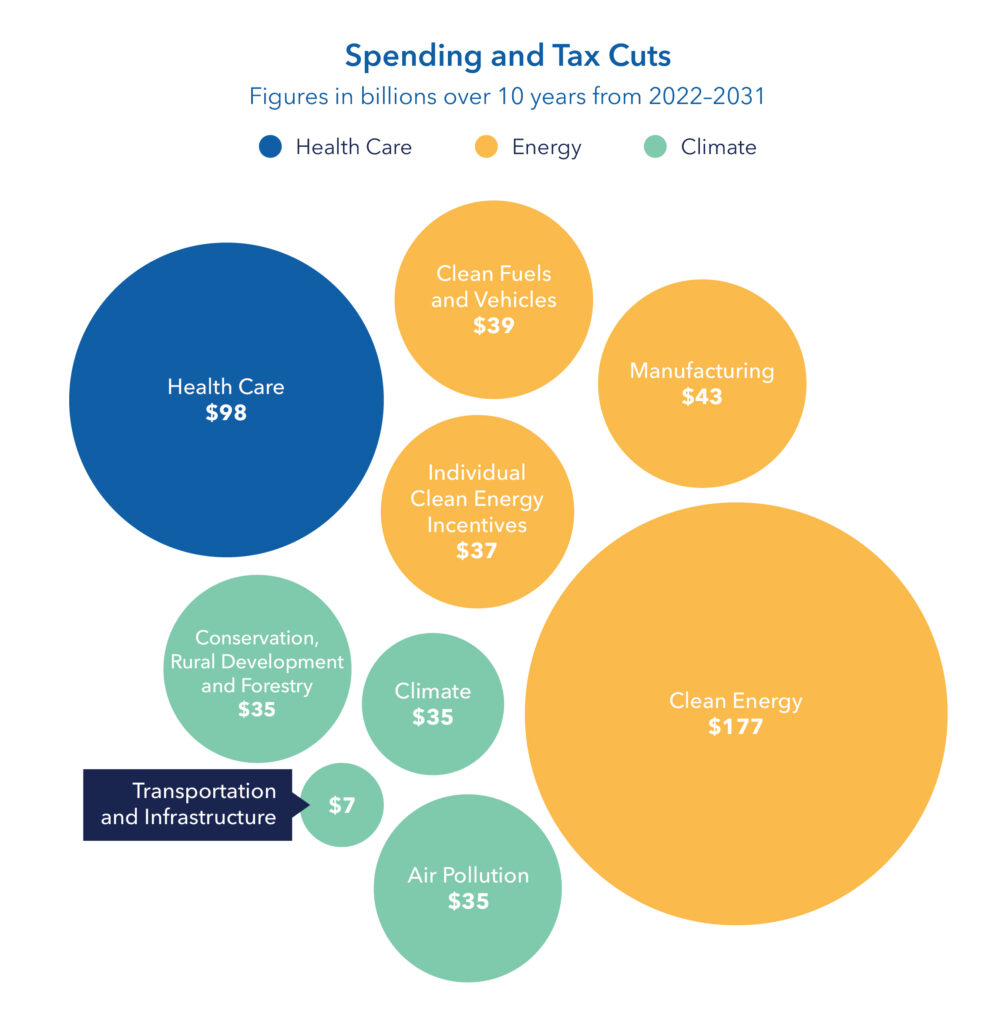

In August 2022, the U.S. Senate and U.S. House of Representatives approved the Inflation Reduction Act of 2022, and President Joe Biden signed the legislation into law on Aug. 16. The $773 billion legislation includes $433 billion of new investments in initiatives related to climate change, authorizes Medicare to negotiate pharmaceutical prices and implements various tax reform measures.
Footnote: Figures in billion and over 10 years (2022-2031)
Sources: Congressional Budget Office Cost Estimates, Joint Committee on Taxation Estimated Budget Effects, Senate Majority Leader Inflation Reduction Act Summary
The $433 billion in new investments include the following:
- Tax rebates and credits for households to lower energy costs and tax credits, loans and grants to increase the domestic production of wind turbines, solar panels, batteries and other energy production and storage. The bill also supports the creation of clean energy jobs and workforce development in disadvantaged communities.
- Tax credits to lower and middle-income families to encourage the sale of new and used electric vehicles.
- Authorization for Medicare to negotiate the prices of prescription drugs. The bill adjusts the annual cap Medicare enrollees pay for out-of-pocket costs for prescription drugs to $2,000 (the current cap is $7,050, with an unlimited 5% coinsurance on prescriptions after that cap is met).
- An extension of the temporary Premium Tax Credits of the Affordable Care Act through 2025. This is a refundable credit used to help low-income individuals and families cover premiums for their health insurance purchased through the marketplace. Under the new eligibility, households with income below 400% of the federal poverty line are eligible.
The Inflation Reduction Act will raise revenue by:
- Creating a 15% minimum tax on corporations with at least $1 billion in income.
- Investing $80 billion over 10 years to improve Internal Revenue Service enforcement for hiring and training new auditors, modernizing antiquated technology reliant on paper returns and improving taxpayer services.
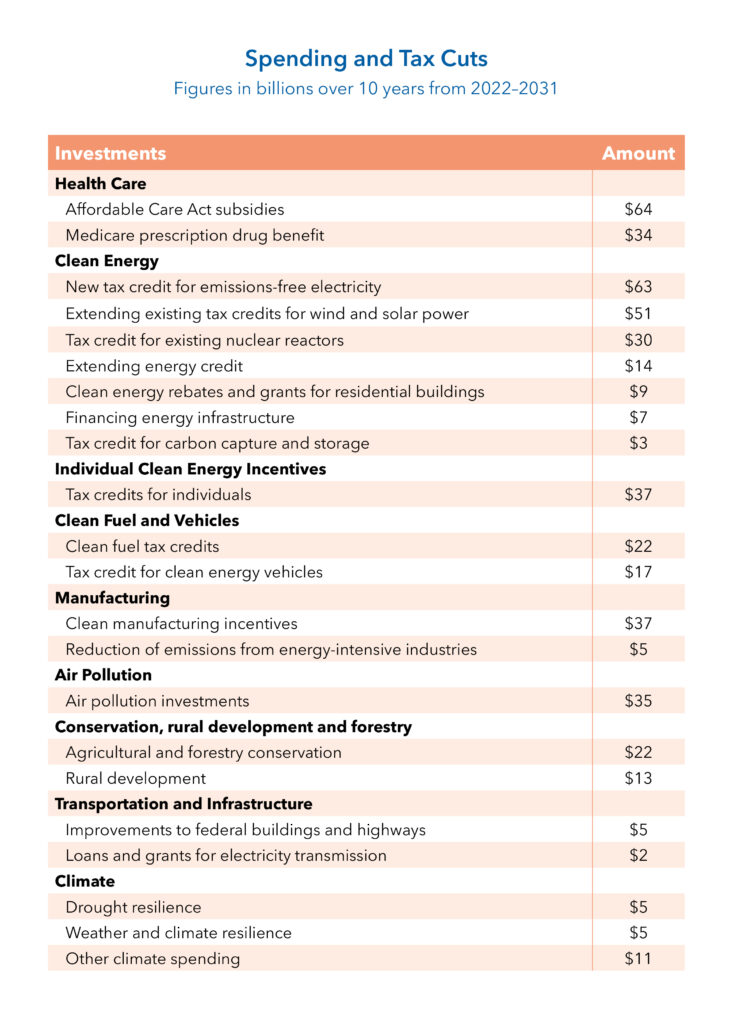
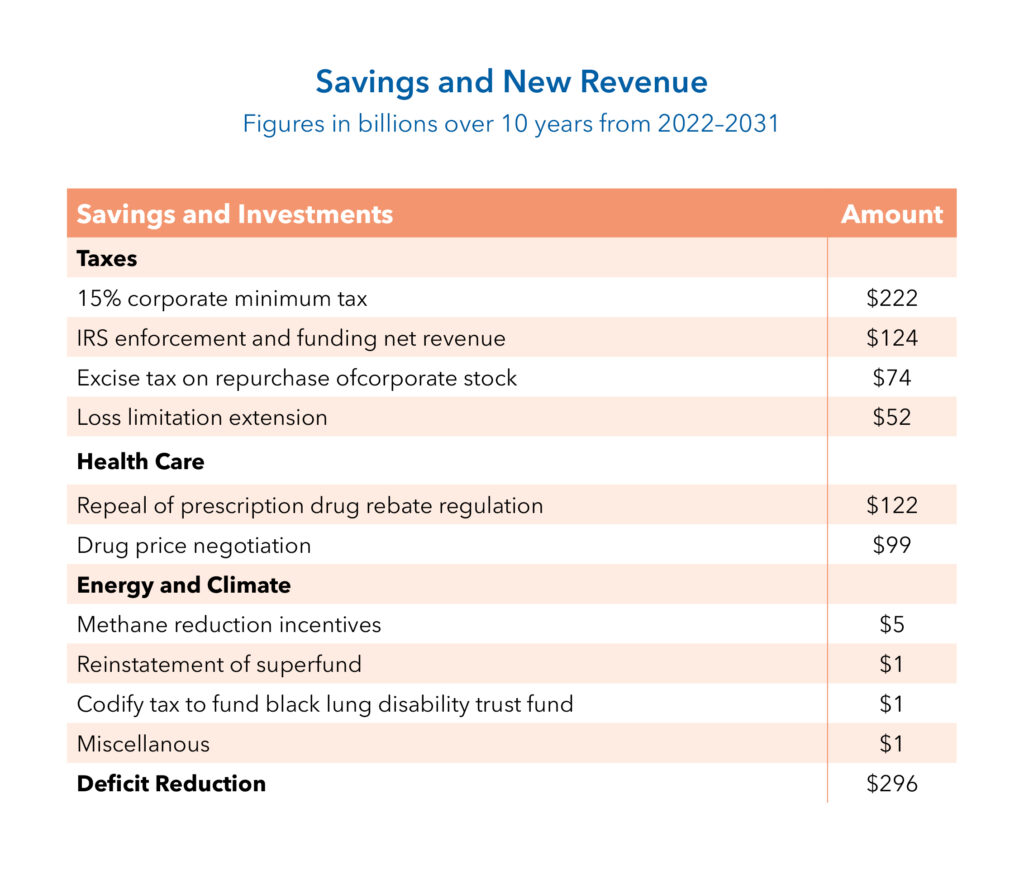
In addition to the spending and policy changes broadly discussed in the media, CSG analysts have compiled elements of the bill that may directly impact state policymakers:
Agriculture
- Provides $125 million to provide services and supports to underserved farmers. (p. 555)
Energy
- Provides $9.7 billion to support the long-term resiliency, reliability and affordability of rural electric systems, in collaboration with rural cooperatives. (p. 552)
- Establishes the Alternative Fuel and Low-Emission Aviation Technology Program. This program includes competitive grants that state and local governments are eligible for, such as $245 million for projects relating to the production, transportation, blending or storage of sustainable aviation fuel and $47 million for projects relating to low-emission aviation technologies. (p. 577)
- Provides $4.3 billion for grants to state energy offices to carry out a Home Owner Managing Energy Savings (HOMES) tax rebate program, giving tax relief to homeowners who reduce their energy use by investing in “whole-house energy savings retrofits.” Rebates are based on the reduction in energy usage. (p. 584)
- Provides an additional $4.3 billion in grants to state energy offices to carry out the High-Efficiency Electric Home Rebate Program, giving tax relieve to homeowners who reduce electricity usage through appliance and non-appliance (e.g., insulation, wiring) upgrades. Rebates are based on purchase costs. (p. 593)
- Provides $200 million for states to develop training programs for contractors involved in the installation of home energy and electrification improvements. (p. 604)
- Provides $760 million for grants to state, local and tribal governments and other entities to support accelerated siting of interstate electricity transmission lines. (p. 619)
Environment
- Provides $700 million in competitive Forest Legacy Program grants to states for the acquisition of land. (p. 567)
- Provides $1.5 billion in competitive Urban and Community Forestry Assistance Program grants to public entities, including state, local and tribal governments. (p. 567)
- Provides $2.6 billion for coastal state, local and tribal local governments and other entities to support coastal community preparation for extreme weather. (p. 572)
- Provides $550 million for grants and other financial assistance to disadvantaged communities for the development of water supply projects. (p. 634)
- Provides $4 billion to mitigate the impact of droughts in Reclamation states. (p. 635)
- Provides $2.3 billion to state, local and tribal governments to reduce air pollution in ports. (p. 663)
- Provides $7 billion for competitive Greenhouse Gas Reduction Fund grants for state, local and tribal governments and other entities to support low-income and disadvantaged communities in benefiting from zero-emission technologies. (p. 667)
- Provides $8 billion for competitive grants to provide financial and technical assistance to low-income and disadvantaged communities to reduce greenhouse gas emissions. (p. 668)
- Provides $17 million for outreach and technical assistance to state, local and tribal governments related to greenhouse gas reduction resulting from domestic electricity generation. (p. 677)
- To reduce greenhouse emissions, the bill provides:
- $250 million for Greenhouse Gas Air Pollution Planning Grants.
- $4.7 billion for Greenhouse Gas Air Pollution Implementation Grants.
States and other public entities are eligible. (p. 694)
- Provides $2.8 billion in grant awards and $200 million for technical assistance for:
- “Community-led air and other pollution monitoring, prevention, and remediation, and investments in low- and zero-emission and resilient technologies and related infrastructure and workforce development that helps reduce greenhouse gas emissions and other air pollutants.
- Mitigating climate and health risks from urban heat islands, extreme heat, wood heater emissions, and wildfire events.
- Climate resiliency and adaptation.
- Reducing indoor toxics and indoor air pollution.
- Facilitating engagement of disadvantaged communities in State and Federal advisory groups, workshops, rulemakings, and other public processes.” (p. 699)
Tribal and local governments are eligible.
- Provides $121 million to address the impact of weather events on federal and state wildlife management areas. (p. 702)
- Provides $75 million for the Tribal Energy Loan Guarantee program.
Health Care
- Increases by 1% the Federal Medical Assistance Percentage for administering vaccines eligible under the Social Security Act. In other words, the bill increases the federal subsidy for the distribution of vaccines, including COVID-19. (p. 227)
- Permanently extends the tax rate to fund the Black Lung Disability Trust Fund. (p. 533)
Infrastructure
- Provides $1.9 billion to the Federal Highway Administration for the competitive neighborhood access and equity grant program to fund a variety of safety, environmental quality and transportation accessibility initiatives. States and other entities are eligible. (p. 704)
- Provides $1.3 billion for projects in economically disadvantaged communities. These projects are to be administered by state transportation departments. (p. 709)
Sources:
- https://www.finance.senate.gov/imo/media/doc/jct_distributional_effects_inflation_reduction_act.pdf
- https://www.taxpolicycenter.org/taxvox/putting-jcts-score-inflation-reduction-act-context
- https://www.democrats.senate.gov/imo/media/doc/inflation_reduction_act_one_page_summary.pdf
- https://budgetmodel.wharton.upenn.edu/issues/2022/7/29/inflation-reduction-act-preliminary-estimates
- https://www.crfb.org/blogs/whats-inflation-reduction-act
Behind the Ballot
Meet just a few of the secretaries of state and chief election officials who administer the nation’s foundational democratic institution.
Continue readingAssociates in Action: International Paper Takes Action to #EndPeriodPoverty
By Victor Montgomery
International Paper, a CSG Associate and the leading global supplier of renewable fiber-based products, has partnered with Always, the leader in global menstrual care, to drive systemic change and address period poverty. The lack of access to period protection, also known as period poverty, is an issue affecting more than 500 million women and girls globally. In the United States alone, nearly 1 in 5 children miss school because they do not have access to the period products they need.
In March 2022, also Women’s History Month, International Paper began hosting a series of period care packing events at its operations across the globe to raise awareness about period poverty. Then in mid-May, International Paper and Always took their collective efforts to Washington D.C. in support of Congresswoman Grace Meng’s Menstrual Equity for All Act and to advocate for systemic change ahead of Menstrual Hygiene Day.
While in D.C., Always and International Paper hosted another packing event alongside Feeding America that provided 500 period product kits to Mary’s Center – a local community health center. Every period care kit contains critical menstrual products donated by Always. By the end of 2022, International Paper and Always are projected to provide more than 25,000 Period Care kits to people across the world.
“International Paper and Always strongly believe in empowering girls and women. When girls have access to the products and resources they need each month, there’s nothing they can’t accomplish,” said Jason Handel, vice president of sales, Global Cellulose Fibers, International Paper. “This effort is aligned with our Vision 2030 goal of impacting 100 million lives. As we strive to be a force for good in our communities, we are proud to partner with Always, and we are incredibly grateful for our team members across the world who are helping resolve this important issue.”
“Since the launch of our #EndPeriodPoverty program in 2018, we have donated over 160 million period products to those in need around the world, including 60+ million products here in the US. We’re thrilled to continue our joint efforts with International Paper to help #EndPeriodPoverty and advocate to bring about societal change so that lack of period protection doesn’t stand in the way of education and confidence ever again,” said Melissa Suk, vice president of North America Feminine Care at Procter & Gamble. “Always has been championing girls’ confidence for more than 35 years and we are excited to collaborate and form alliances with individuals and organizations – like International Paper – who share the same mission as this will play a critical role in helping solve period poverty.
To learn more about how you can help International Paper and Always #EndPeriodPoverty, please view this video and visit the Always #EndPeriodPoverty webpage.
Understanding the New Semiconductor Legislation
The bipartisan Creating Helpful Incentives to Produce Semiconductors for America Fund Act (also known as CHIPS) has passed both the U.S. Senate and House of Representatives, and President Joe Biden plans to sign the legislation Aug. 9 in a Rose Garden ceremony.
While most media coverage has focused on the bill’s substantial investment in the private sector semiconductor industry, there are several components that are important to state policymakers, particularly in the areas of research, education and workforce development.
The bill is designed to counter increasing competition from China in technological innovation. The $280 billion legislation will “provide for international information and communications technology security and semiconductor supply chain activities, including to support the development and adoption of secure and trusted telecommunications technologies, secure semiconductors, secure semiconductors supply chains, and other emerging technologies.”
The bill will:
- Support clean water and watershed research in collaboration with state, territorial, local and tribal governments. (p. 148)
- Support greenhouse gas research, including federal agency coordination with state and local governments. (p. 291)
- Establish a National Supply Chain Database, through which the federal government will work with state and local governments to minimize “disruptions to the United States supply chain by having an assessment of United States manufacturers’ capabilities.” (p. 357)
- Support a National Academies study to foster innovative, evidence-based science, technology, engineering and math education practices from pre-K through 12th grade (p. 385)
- Establish a National Science, Technology, Engineering, and Math Teacher Corps Pilot Program that honors outstanding STEM teachers and “rewards them for their accomplishments, elevates their public profile, and creates rewarding career paths.” (p. 393)
- Develop initiatives, including scholarships-for-service and postdoctoral fellowships, to support a pipeline of professionals in Artificial Intelligence to meet the workforce needs of state, territorial, local and tribal governments. (p. 425)
- Fund undergraduate scholarships, graduate fellowships and traineeships and postdoctoral awards in science, technology, engineering and math fields. (p. 459)
- Work through the Established Program to Stimulate Competitive Research program to expand geographic and institutional diversity in research. (p. 466)
- Establish a National Secure Data Service demonstration project “to develop, refine, and test models to inform the full implementation of the Commission on Evidence-Based Policymaking recommendation for a governmentwide data linkage and access infrastructure for statistical activities,” in consultation with state governments. (p. 557)
- Establish the Directorate for Technology, Innovation, and Partnerships to provide grants to public and private sector entities to advance technology research and development. (p. 562)
- Provide funding for Regional Innovation Engines to “further the development, adoption, and commercialization in key technology focus areas” through partnerships involving State, territorial, local and Tribal governments. (p. 577)
- Establish technology planning and capacity building awards for state and local governments, among others, to advance the development and commercialization of technologies. (p. 589)
- Direct the Comptroller General to evaluate the impact of federal science, technology, engineering and math programs on rural populations. (p. 675)
- Establish Regional Technology and Innovation Hub Program to encourage state, territorial, local and tribal governments to work with other public and private entities to develop innovation strategies to support economic development and resilience. This includes Strategy Implementation Grants and Cooperative Agreements for state, territorial, local and tribal governments to create job training and other workforce programs to meet the needs of local employers. (p. 742)
- Establish Regional Clean Energy Innovation Partnerships for state, territorial, local and tribal governments to work with other public and private entities “to enhance the economic, environmental, and energy security of the United States and accelerate the pace of innovation of diverse clean energy technologies.” (p. 790)
- Establish Coastal and Ocean Acidification Research and Innovation program to “to advance our Nation’s ability to understand, research, or monitor ocean acidification or its impacts, or to develop management or adaptation options for responding to ocean and coastal acidification.” This would include National Oceanic and Atmospheric Administration Ocean Acidification Activities grants for vulnerable state, territorial, local and tribal governments. (p. 821)



